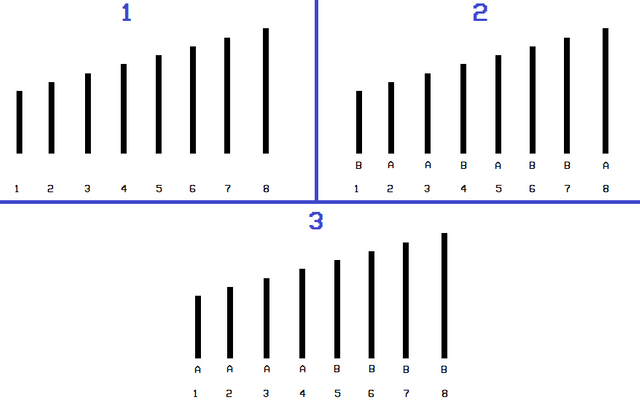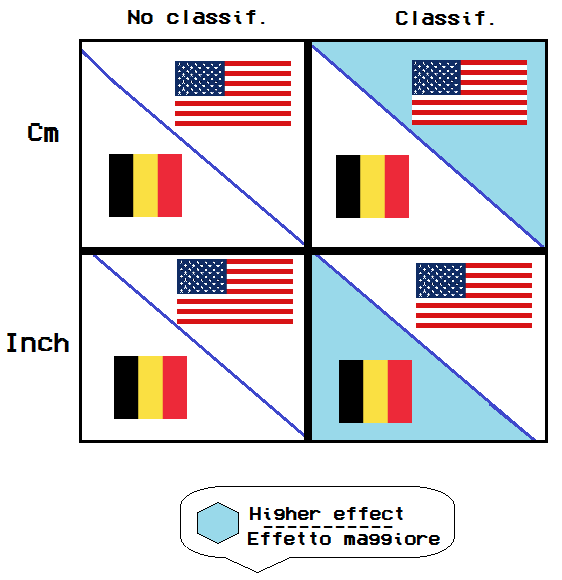SOCIAL PSYCHOLOGY: Racism toward straight lines #1 - PSICOLOGIA SOCIALE: Razzismo verso le linee dritte #1 [ENG-ITA]

In years to come we will probably hear more and more about gender and racial discrimination.
Negli anni che verranno sentiremo probabilmente parlare sempre più spesso di discriminazione di genere e razziale.
Before trying to tackle these issues we need to be very clear in what constitutes a process of categorization (and consequent labeling) that underlies any discriminatory phenomenon.
Prima di provare ad affrontare questi argomenti dobbiamo avere ben chiaro in cosa consista un processo di categorizzazione (e di conseguente etichettamento) che sta alla base di qualsiasi fenomeno discriminatorio.
The discipline that deals with these and many other issues is called "Social Psychology" and bases its theories in a rich heritage of experiments that unravel from the first half of the '900 to the present day.
La disciplina che si occupa di queste e di tante altre tematiche si chiama "Psicologia sociale" e fonda le sue teorie in un ricco patrimonio di esperimenti che si dipanano dalla prima metà del '900 ai giorni nostri.
At the same time that social psychology develops, the positivist and behaviorist illusion that sees human beings as perfectly programmed and programmable machines begins to decline.
Nello stesso periodo in cui si sviluppa la psicologia sociale, l'illusione positivista e comportamentista che vede gli essere umani come macchine perfettamente programmate e programmabili si avvia al declino.
In fact, humans do not acquire the information by recording it faithfully from the flow of data coming from an external and objective reality, as a video camera would, but they build subjective reality by carefully selecting the information according to the meaning that it represents for each individual.
Gli umani infatti non acquisiscono le informazioni registrandole in maniera fedele dal flusso di dati proveniente da una realtà esterna ed oggettiva, come farebbe ad esempio una videocamera, bensì costruiscono la realtà soggettiva selezionando accuratamente le informazioni in base al significato che esse rappresentano per ogni individuo.
This process is not only valid for complex phenomena such as interactions between social or ethnic groups but also for basic phenomena such as the visual estimation of a measure.
Questo processo non vale solamente per fenomeni complessi come appunto le interazioni tra gruppi sociali o etnie ma anche per fenomeni basilari come ad esempio la stima visiva di una misura.
The 1963 experiment by Tajfel and Wilkes gives us an elementary demonstration of the phenomenon.[1]
L'esperimento di Tajfel e Wilkes del 1963 ci fornisce un'elementare dimostrazione del fenomeno.[1]
The two scientists present a series of 8 lines to a group of English students.
I due scienziati presentano ad un gruppo di studenti inglesi una serie di 8 linee.
The first line measures 16.2 cm and the following ones measure each 5% more than the previous one, up to the last that measures 22.8 cm. Students obviously do not know this and must estimate their length by eye.
La prima misura 16,2 cm e le successive misurano ognuna il 5% in più della precedente, fino all'ultima che misura 22,8cm. Gli studenti ovviamente non lo sanno e devono stimarne la lunghezza ad occhio.

Then they divide the students into 3 experimental groups:
Dividono poi gli studenti in 3 gruppi sperimentali:
- To those of the first group they present the lines as they are without adding anything. This control group serves for comparison with the other two.
- To those of the second group they present the lines with a random categorization, i.e. they randomly associate each line to the letter A or to the letter B.
- To those of the third group they present the lines with a systematic categorization, i.e. they associate the letter A for the first 4 shortest and the letter B for the other four longer ones.
- A quelli del primo gruppo presentano le linee così come sono senza aggiungere nulla. Questo gruppo di controllo serve per il confronto con gli altri due.
- A quelli del secondo gruppo presentano le linee con una categorizzazione casuale, ovvero associano ogni linea alla lettera A oppure alla lettera B, il tutto in maniera casuale.
- A quelli del terzo gruppo presentano le linee con una categorizzazione sistematica, ovvero associano la lettera A per le prime 4 più corte e la lettera B per le altre quattro più lunghe.

Scientists hypothesize to find two effects in this experiment:
An intracategorial assimilation and an intercategorial accentuation.
Gli scienziati ipotizzano di trovare due effetti in questo esperimento:
Un'assimilazione intracategoriale ed una accentuazione intercategoriale.
In other words, they expect that the students of the third group (to which the categorized lines are presented in an orderly manner) will judge as more similar two close lines belonging to the same category, judging instead as less similar the lines 4 and 5 that, despite being as close as the previous ones, belong to two different categories.
In altre parole, si aspettano che gli studenti del terzo gruppo (al quale vengono presentate le linee categorizzate in maniera ordinata) giudichino come più simili due linee vicine appartenenti alla stessa categoria, giudicando invece meno simili le linee 4 e 5 che, pur avendo la stessa differenza delle precedenti, appartengono a due categorie diverse.
The lines 2 and 3 should therefore seem more similar than the lines 4 and 5 even if the difference in length is objectively the same (5%).
Le linee 2 e 3 dovrebbero sembrare quindi più simili delle linee 4 e 5 anche se la differenza di lunghezza risulta oggettivamente la stessa (5%).
In this experiment only the second effect emerges, that is, even if the students can correctly estimate the lines belonging to the same category (no intracategorial assimilation), they are wrong to judge lines 4 and 5 (intercategorial accentuation) because they consider them very different due to the fact that they are in two distinct categories.
In questo esperimento si evince solamente il secondo effetto, ovvero anche se gli studenti riescono a stimare in maniera corretta le linee facenti parte della stessa categoria (niente assimilazione intracategoriale), sbagliano a giudicare le linee 4 e 5 (accentuazione intercategoriale) perché le ritengono molto diverse a causa del fatto che si trovano in due categorie distinte.
The intercategorial accentuation could be due to a phenomenon called "assimilation to the central tendency", i.e. the characteristics of the members of a group seem similar to the characteristics present on average in the group itself.
If a group contains short lines, all lines seem similar to the average length, even those that are at the ends of the group.
If a group contains short lines, all lines seem similar to the average length, even those that are at the ends of the group.
L'accentuazione intercategoriale potrebbe essere dovuta ad un fenomeno chiamato "assimilazione alla tendenza centrale", ovvero le caratteristiche dei membri di un gruppo sembrano simili alle caratteristiche presenti in media nel gruppo stesso. Se un gruppo contiene linee corte, tutte le linee sembrano simili alla lunghezza media, anche quelle che si trovano agli estremi del gruppo.
Let us pause now to make a small reflection on the experiment. The scientists turned to English students, accustomed to using the imperial measurement system, and asked them to estimate the measurement in centimeters. What would have happened if they asked them to estimate the inch measurement as used in England?
Soffermiamoci ora a fare una piccola riflessione sull'esperimento. Gli scienziati si sono rivolti a studenti inglesi, abituati ad usare il sistema di misurazione imperiale, ed hanno chiesto loro di stimare la misura in centimetri. Cosa sarebbe successo se avessero chiesto loro di stimare la misura in pollici come si usa fare in Inghilterra?
The answer comes from a second experiment on the lines made 40 years later. This time it includes 3 parameters.[2]
La risposta ci arriva da un secondo esperimento sulle linee effettuato 40 anni dopo. Questa volta comprende 3 parametri.[2]
So we have 2x2x2 = 8 different situations.
Abbiamo quindi 2x2x2=8 situazioni diverse.

Scientists predict that students will be very influenced in categorization when this is ordered (just as in the previous experiment) but especially when they have to make an estimate using a unit of measurement that they are not accustomed to.
Gli scienziati prevedono che gli studenti saranno molto influenzati nella categorizzazione quando questa risulta ordinata (proprio come avveniva nell'esperimento precedente) ma soprattutto quando essi devono fare una stima utilizzando un'unità di misura alla quale non sono abituati.
The results of the experiment confirm this prediction: the ordered categorization has a greater effect when the students have to use a unit of measurement different from their own.
I risultati dell'esperimento confermano questa previsione: la categorizzazione ordinata ha un effetto maggiore quando gli studenti devono utilizzare un'unità di misura diversa dalla propria.
This means that categorization processes and stereotypes in general have more grip on people when they are in a situation of uncertainty in which they have little information.
Ciò significa che i processi di categorizzazione ed in generale gli stereotipi hanno più presa sulle persone quando queste si trovano in una situazione di incertezza in cui dispongono di poche informazioni.
In the second part of this article we will see how in addition to the categorization itself, also the type of label that we attribute to the categories affects our judgment.
Nella seconda parte di questo articolo vedremo come oltre alla categorizzazione in sè, anche il tipo di etichetta che attribuiamo alle categorie influisce sul nostro giudizio.

⚫YouTube: link
⚫Instagram: link
[2] ON THE ROLE OF FAMILIARITY WITH UNITS OF MEASUREMENT IN CATEGORICAL ACCENTUATION: TAJFEL AND WILKES (1963) REVISITED AND REPLICATED. Olivier Corneille, Olivier Klein, Sophie Lambert, Charles M. Judd. Psychological Science. Vol 13, Issue 4, pp. 380 - 383. First Published July 1, 2002 https://doi.org/10.1111/1467-9280.00468
© All pictures are mine - Tutte le foto sono mie
Stai assumendo come noti al pubblico il significato di positivista e comportamentista.
Hai ragione, anche se un po' di evinceva dalla mia critica ad essi, ho aggiunto i link :D
Hello, please follow the rules of the group Steemit for Resteem ↕ and you will be resteemed by the most active members in the group.
You have to resteem a post from the group before you post yours there.
Here is : HOW TO RESTEEM ON STEEMIT ?
good quality post, thanks, upvoted ☺
Thank you, I appreciate it :)
Wow! this is a really nice post! With translation on the other side... best of luck! God bless 😊
Yeah, I was actually surprised by the quality! Thanks for resteeming it.
@melanie0625 and @cryptosharon , thank both of you :D part two is coming ;)